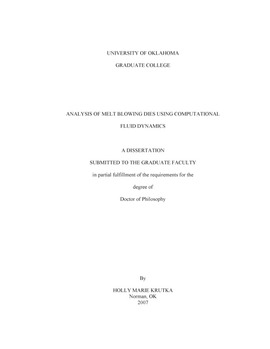| dc.contributor.advisor | Papavassiliou, Dimitrios V., | en_US |
| dc.contributor.advisor | Shambaugh, Robert L., | en_US |
| dc.contributor.author | Krutka, Holly Marie. | en_US |
| dc.date.accessioned | 2013-08-16T12:21:02Z | |
| dc.date.available | 2013-08-16T12:21:02Z | |
| dc.date.issued | 2007 | en_US |
| dc.identifier.uri | https://hdl.handle.net/11244/1313 | |
| dc.description.abstract | For a single annular jet and the blunt slot die, a previously developed rheological model was used to predict the fiber diameter, velocity, and temperature. Then, these were used to set boundary conditions in simulations to study the effect of the fiber on the air profiles. Close to the fiber edge, the interactions between the air and fiber are important. | en_US |
| dc.description.abstract | Computational Fluid Dynamics (CFD) was used to study the air flow from different types of melt blowing dies. Specifically, the types of dies studied include Exxon slot dies, Schwarz multihole dies, and swirl dies. For the slot dies, the Reynolds Stress Model with modifications matched the experimentally measured velocity profiles. After the experimental measurements were matched, the RSM was used to study the effect of changing the angle between the air jets and the die face. Simulations were completed for melt blowing dies that have not been tested experimentally. Decreasing this angle changed the centerline velocity profile. For sharp slot dies, the effect of the nose piece placement was also examined. The more inset above the die face the nose piece, the higher the maximum centerline air velocity. However, the centerline turbulence intensity also increased. Non-isothermal simulations were run for all slot die geometries to study the effect of the jet geometry on the temperature profiles. The Schwarz melt blowing die was also examined. The k-epsilon turbulence model was used to simulate the air flow from this die. The spacing between the annular jets was changed, and the effect of the jet spacing on the centerline velocity, temperature decay, and turbulence was studied. Finally, the isothermal air flow from a swirl melt blowing die was measured experimentally and simulated using CFD. | en_US |
| dc.format.extent | xix, 363 leaves : | en_US |
| dc.subject | Polymer melting. | en_US |
| dc.subject | Fluid dynamics Mathematical models. | en_US |
| dc.subject | Engineering, Chemical. | en_US |
| dc.title | Analysis of melt blowing dies using computational fluid dynamics . | en_US |
| dc.type | Thesis | en_US |
| dc.thesis.degree | Ph.D. | en_US |
| dc.thesis.degreeDiscipline | School of Chemical, Biological and Materials Engineering | en_US |
| dc.note | Advisers: Dimitrios V. Papavassiliou; Robert L. Shambaugh. | en_US |
| dc.note | Source: Dissertation Abstracts International, Volume: 68-12, Section: B, page: 8200. | en_US |
| ou.identifier | (UMI)AAI3294670 | en_US |
| ou.group | College of Engineering::School of Chemical, Biological and Materials Engineering | |
